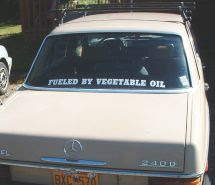 Everyone wants to know HOW MUCH DOES IT COST? To run on used vegetable oil, that is. Well, it's really a case of penny wise, pound foolish - or, you get what you pay for. Our systems have bomb-proof components and lots and lots of heat to protect your injection pump in the Alaska winters.
Everyone wants to know HOW MUCH DOES IT COST? To run on used vegetable oil, that is. Well, it's really a case of penny wise, pound foolish - or, you get what you pay for. Our systems have bomb-proof components and lots and lots of heat to protect your injection pump in the Alaska winters.Prices as of Feb 2008 for a 1981 Volkswagen Rabbit Diesel:
$450 Basic PlantDrive TTVTS kit includes:
$150 Vegtherm Standard
$215 VegMax Filter
$89 1st - 3-port Hydraforce valve (option)
Assorted wires/connectors/fittings
additional PlantDrive parts:
$89 2nd - 3-port Hydraforce valve
$125 HP-16 Hotplate with 3/8" fittings
$450 Heated 12 Gallon Trekker Poly Tank
other tank options:
$209 HotFox with $0 existing tank
$209 HotFox with ~$400 aluminum tank
$1114 + 15% Alaska shipping $167.10
$1281.10 PlantDrive subtotal - this is what we can sell you if you want to do-it-yourself.
$600 (rough estimate) fittings/electrical/hardware/hose/sealant/insulation/etc.
$1821.10 parts subtotal estimate
$650 labor for Alaska Standard install (about 2 1/2 days)
$2471.10 Installed estimate for the bomb-proof 4-season Alaska Standard system.
We can install a no-frills 3-season system for a substantial savings, but we recommend the Alaska Standard for our climate. Deluxe options are available (gauges/controllers/pre-heaters), but our basic components are rock-solid in the standard system.
Shipping discounts may be available for folks picking up at our Chugiak (Anchorage) location, especially if your shipping times are flexible.
Pickup trucks require some higher-flow components and additional labor, and will cost a few hundred dollars more.
Veg On!




